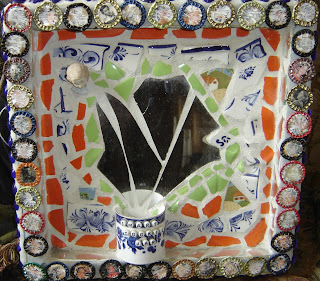A multimedia exhibit and word performance by eight Pioneer Valley women:
Lea Banks, Trish Crapo, Edite Cunha, Candace Curran, Elizabeth MacDuffie,
Diana Pedrosa, Nina Rossi and Samantha Wood
Dynamic. Physical. Linking and exploding boundaries between word and vision, personal and public, with static and moving parts.
Each artist was tasked with finding a way to work with this idea of the exploded view, that shows parts relative to a whole, breaks something apart or explains a way of seeing the relationships between parts, whole or broken. Each has created a piece of visual art and a poetic text. Some of the art is sculpture, installation, three dimensional, some is collage and drawing, some digital.
Works in progress -- the group will have its first show during the Greenfield Annual Word Festival in October 2016 in Greenfield, Massachusetts. Here is a taste of some of the work by these artists. Some of these are previous works and some in progress for the Exploded View show.
 |
| Trish Crapo. Why Does the Knife. |
 |
| Edite Cunha. There was Something I was Supposed to Tell. |
 |
| Trish Crapo |
 |
| Edite Cunha. Fervor from the Truth |
 |
| Elizabeth MacDuffie. Hey, baby (prototype). |
 |
| Diana Pedrosa. Date Night |
 |
| Nina Rossi. Head. |
 |
| Nina Rossi |
 |
| Diana Pedrosa |
 |
| Samantha Wood. Uncertainty Cube. |
More work and other projects by these artists can be seen at:
Lea Banks: leabanks.com
Elizabeth MacDuffie: Meat for Tea: The Valley Review meatfortea.com
Diana Pedrosa: www.ixchelailee.wix.com/artwork
Nina Rossi: Nina's Nook ninasnook.com
Exploded View was conceived by Candace Curran, who showed up in my studio one day hauling a stack of old auto repair guides, saying "I've fallen in love with parts manuals, what do you think of this?"
Poet and librarian by trade, Curran has a history of bringing people together to make something new.
She produced Interface, a collaboration of word and image, which included a dozen events between 1993 and 2010 in the Haley's Publishing barn, the 1794 Meetinghouse, New Salem, Orange Innovation Center, Montague Book Mill .... These events were a marriage between poet and artist. Artists included were Les Campbell, Norah Dooley, Linda Ruel Flynne, J.R. Greene, Dorothy Johnson, Susan Pepper Aisenberg, Donna Estabrooks, Janet Macfadyen, Richard Baldwin, Jean Stabell, Candace Anderson, Alice Schertle, Barbara Ellis, Hugh Bloomingfield, Amy Fagan, Julia Penelope, Renata Sylvia Pienkawa, Cathy Stanton.
Artist bios:
Lea Banks is the author of All of Me (Booksmyth Press, 2008) and forthcoming collection The Bottomland. She lives in Western Massachusetts, is the Poetry Coordinator for the Brattleboro Literary Festival in Vermont, and founder of the Collected Poets Series in Shelburne Falls, Mass. Banks has published in several journals including American Poetry Journal, Connotation Press, Big River Poetry Review, Poetry Northwest, Slipstream, Diner Sweet,San Pedro River Review, Town Creek Poetry, The Laurel Review. She has recent work in Meat for Tea, and off the margins where she was the guest poet. She has work forthcoming in Queens of Cups.
Trish Crapo is a poet, writer, photographer and multimedia artist working in western Massachusetts. Her photography and art have been exhibited throughout New England, at the New School in New York City and in Moscow and Tula, Russia. Her book Dune Shack is a collection of images and words, made among the dunes on Cape Cod from a residency in 2013. Her chapbook Walk Through Paradise Backwards was published by Slate Roof Press in 2004. Her poetry has been published widely, including in Southern Poetry Review, Bark and Meat for Tea. She covers poetry and the arts for The Recorder.
Edite Cunhā is a writer, artist, teacher and activist. Her fiction has been published both locally and nationally and won awards and fellowships including Smith’s Spencer Prize for Excellence in Writing, AWP’s Intro Writing Award and the Tara Fellowship for short fiction. She has been a fellow at the Vermont Studio Center, A Room of Her Own and the Disquiet Literary Program. She believes that creativity can transform the individual as well as society, and leads creative writing and multi-media art workshops for people of all ages. Cunhā has a BA from Smith College and an MFA from Warren Wilson College. She lives in Turners Falls, Mass.
Elizabeth MacDuffie, along with Alexandra Wagman, founded Meat for Tea: The Valley Review over a decade ago. She is a proud and enthusiastic member of the Exploded View group. She lives in a house with a blue kitchen, in which she enjoys creating epicurean delights.
Diana Pedrosa is a multi media artist who goes by the alias ixchelailee or ixchel. She combines past photography education and passion for image transfer with her tactile inclinations towards fibers and patterns. Her materials include pattern paper, electrical, scotch, & gaffer's tape, found and appropriated images, photographs & photocopies, glue and paint and most recently digital photo editing programs. She lives in Turners Falls, Massachusetts.
Nina Rossi is an artist and writer in Turners Falls, Massachusetts, who is known for her odes to abandoned shopping carts and her sculptures of garden slugs, among other diverse creations, and her ridiculously narrow Nook gallery.
Samantha Wood is a writer, artist and editor living in western Massachusetts.

